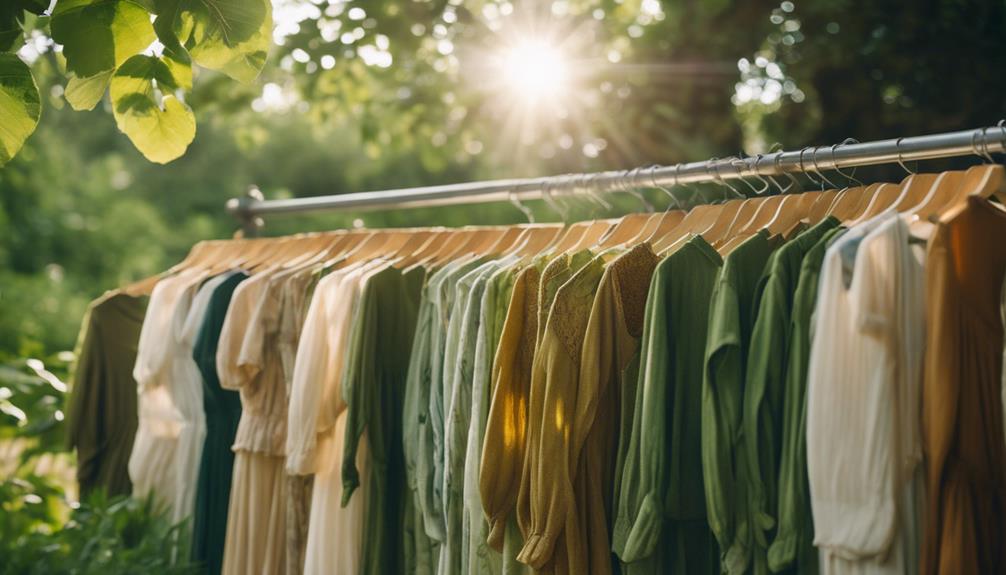Sustainable fashion may not always be as environmentally friendly as it claims. While some brands advertise themselves as eco-friendly, many still rely on non-biodegradable, petroleum-based materials. Despite efforts such as bio-based fabrics and rental services, the industry’s overall environmental impact remains significant. Greenwashing is widespread, with companies promoting practices that are slightly less unsustainable while failing to address issues like overproduction and excessive consumption. True sustainability necessitates systemic changes and collaboration among all stakeholders. If you are curious about what genuine sustainability entails, or why these challenges persist, you may discover surprising insights that challenge conventional beliefs.
Key Takeaways
- The fashion industry's environmental impact has stagnated for 25 years, with minimal change despite claims of sustainability.
- Many eco-friendly labels are misleading, as products often lack significant environmental benefits.
- Innovations like bio-based fabrics and rental services do not address overproduction and overconsumption issues.
- Regulation is crucial for accountability, promoting transparency and enforcing sustainable practices in the industry.
Industry Claims Vs. Reality
Despite the fashion industry's claims of being sustainable, the reality is that its environmental impact has barely budged in the last 25 years. You might think that with all the buzz around sustainable fashion, things would be getting better. However, most clothing is still produced using non-biodegradable, petroleum-based materials. High-profile innovations, like bio-based fabrics and rental services, haven't made a dent in reducing the overall environmental footprint.
This disconnect often leads to greenwashing, where brands market themselves as eco-friendly without implementing real, meaningful changes. You might encounter numerous products tagged as sustainable, yet many of these offerings—like carbon-positive or organic items—often fail to deliver significant environmental benefits. This can create a misleading picture of what true sustainability looks like in fashion.
Market-based solutions alone haven't been effective in addressing the sustainability crisis, highlighting the urgent need for regulatory measures to hold companies accountable. As a consumer, it's essential to remain aware of the difference between genuine sustainable practices and mere marketing tactics designed to create the illusion of responsibility.
Innovations and Their Shortcomings

While the fashion industry promotes innovations like bio-based materials and recycling initiatives, these advancements often fall short of delivering real change in sustainability. Many sustainable brands boast about their efforts, yet the overall environmental impact of the industry has remained unchanged for decades. Concepts like Rent-the-Runway haven't greatly reduced waste or pollution, revealing the limitations of current sustainable business models.
The table below highlights the gap between innovation and actual sustainability:
| Innovation | Shortcoming |
|---|---|
| Bio-based materials | Still contributes to overproduction |
| Recycling initiatives | Doesn't curb fast fashion practices |
| Rent-the-Runway | Limited impact on waste reduction |
| Resale platforms | Fails to tackle overconsumption |
| 'Less unsustainable' practices | Misleading notion of true sustainability |
You might notice that many sustainable practices focus on superficial changes instead of addressing the core issues driving environmental degradation. The industry often misleads consumers into thinking they're making a difference when, in reality, these innovations don't challenge the prevailing fast fashion model.
The Role of Regulation

Regulation plays an essential role in guaranteeing fashion companies are held accountable for their environmental impacts, pushing them towards genuine sustainability. Current market-based solutions often fall short, making regulatory intervention necessary.
By enforcing stricter guidelines on production practices, governments can compel brands to adopt sustainable methods instead of relying on misleading marketing claims.
Implementing robust regulatory frameworks means companies must disclose their environmental impact, promoting transparency in their operations. This transparency helps you, as a consumer, make informed choices about the brands you support.
Additionally, regulations could require companies to bear the costs associated with their environmental footprint, creating a financial incentive to adopt sustainable practices, such as using organic cotton.
Ultimately, a collaborative approach among regulators, manufacturers, and consumers is required to drive systemic change within the fashion industry. By holding companies accountable, regulations can push for true sustainability rather than superficial efforts that only serve as greenwashing.
If you're passionate about sustainable fashion, advocating for stronger regulations is crucial to guarantee that the industry moves towards practices that genuinely benefit the planet and its people.
Evaluating New Business Models

As you explore new business models in sustainable fashion, it's vital to recognize that many of these innovations often fail to effectively address the industry's core issues of overproduction and overconsumption.
While recycling, resale, rental, and repair options are marketed as solutions, they frequently lack the impact needed to considerably reduce environmental harm.
These business models aim to promote circularity, yet they don't tackle the fundamental causes of environmental degradation inherent in the fashion industry.
For these models to succeed, consumer behavior must align with industry practices, a goal that hasn't been achieved on a large scale. Although initiatives like Rent-the-Runway showcase innovative approaches, they often fall short of creating substantial positive change.
Ultimately, a genuine shift toward sustainability requires more than isolated innovations; it demands a systemic change in production and consumption patterns.
Without addressing the root causes of waste, these business models may only provide a temporary fix rather than a lasting solution.
To make a real difference, it's vital to rethink how we produce and consume fashion, going beyond surface-level changes to create a more sustainable future.
Future Directions for Sustainability

A meaningful shift toward sustainability in fashion hinges on collaborative efforts that tackle the industry's fundamental environmental challenges. To make sure we're moving in the right direction, here are some future directions you should consider:
- Systemic Change: Focus on reforms that address root causes of environmental degradation rather than just isolated innovations.
- Collaboration: Encourage partnerships among brands, suppliers, and consumers to share knowledge and resources for sustainable practices.
- Education: Equip the average person with the information needed to understand sustainability's true impacts, empowering them to make informed choices.
- Regulatory Frameworks: Support policies that hold companies accountable for their environmental impact and promote sustainable business practices.
Frequently Asked Questions
Can Fashion Really Be Sustainable?
You might wonder if fashion can truly be sustainable. While some brands promote eco-friendly practices, the industry's overall impact remains significant. Real change requires addressing production and consumption patterns rather than relying on superficial solutions. As consumers, it is important to question whether the current efforts in the fashion industry are truly making a difference in the long run. Is sustainable fashion truly sustainable if it only focuses on recycling materials or using organic fabrics? The true challenge lies in rethinking the entire production process and reducing the overall demand for fast fashion. It requires a shift in mindset from both consumers and producers to create a truly sustainable fashion industry.
Do People Really Care About Sustainable Fashion?
You might think people genuinely care about sustainable fashion, yet studies reveal a different story. While many express interest, price and style often win out, leading to a disconnect between values and actual purchasing decisions.
Why Is Sustainable Fashion so Important?
Sustainable fashion's important because it reduces environmental harm, promotes ethical practices, and encourages responsible consumption. By choosing sustainable options, you can help minimize waste, support fair labor, and contribute to a healthier planet for future generations.
What Does Sustainable Fashion Mean to You?
Sustainable fashion means you prioritize ethical choices in your wardrobe. You seek quality over quantity, embrace thrifting, and support brands that align with your values, all while reducing your environmental impact and promoting fair practices.
Conclusion
So, is sustainable fashion really sustainable?
While the industry touts green initiatives and innovative practices, the reality often falls short of the promise.
You've seen how new business models and regulations can push for change, but without genuine commitment, it's all just smoke and mirrors.
As you consider your next purchase, remember: true sustainability isn't just a trend; it's a movement.
Are you ready to be part of a future that values the planet over fast fashion?









